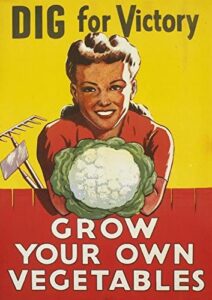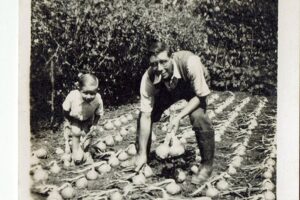In today’s #ForgottenFriday we are delving into the Home Front and are exploring the Dig for Victory Campaign!

Dig For Victory
The ‘Dig for Victory’ campaign was launched in October 1939, following the outbreak of World War Two, by the British Ministry of Agriculture. Men and women across the country were encouraged to grow their own food in times of harsh rationing. Open spaces everywhere were transformed into allotments, from domestic gardens to public parks – even the lawns outside the Tower of London were turned into vegetable patches and The Royal Family sacrificed their rose beds for growing onions.

Leaflets and monthly issues of ‘Home-Grown Food’ were part of a massive propaganda campaign aiming both to ensure that people had enough to eat, and that morale was kept high. It was the contribution to the war effort that counted in hindsight. It was the government’s overall initiative to encourage morale and contribution to war for those at the home front, any form of rationing or possible initiative to help the war came into immediate action.
From the moment of the release of the campaign, the Home Front in Britain were encouraged to partake in creating their private gardens into small allotments. This would provide the essential ingredients for families and the community, and free up space for important war materials on the merchant shipping convoys. By 1943, over a million tons of vegetables were being grown in as many gardens and allotments as possible.

Throughout the war itself, many propagandist moves were made to promote growing their own food and portray the importance to do so. In addition to this, many poster displays, anthems, and poetry was produced. Such anthems encouraged morale.
To encourage children and their families to eat vegetables and other essential ingredients, ‘Doctor Carrot’ and ‘Potato Pete’ were introduced into society. These specific propagandist moves, encouraged families to utilise their home-grown vegetables in many ways. For example, curried carrot, carrot jam and ‘carrolade’ (a fizzy drink containing carrots and parsnips) were suggested. Similarly, potatoes were shown extra ways of usage. Women were advised to scrub the potatoes instead of peeling them to avoid unnecessary waste!
How was this successful during the war? The campaign itself was that successful, it was estimated that 1.4 million people had allotments. The wartime ‘Dig for Victory’ principles of eating seasonal food that was grown locally and organically has a sown message in society today. Nearly 80 years since the ‘Dig for Victory’ campaign was launched, it is still completely relevant for people today.

The ‘Dig for Victory’ garden at Eden Camp Modern History Museum is kept full of delicious vegetables and fruits to keep the visitors full all year round! There’s no rationing around here!

